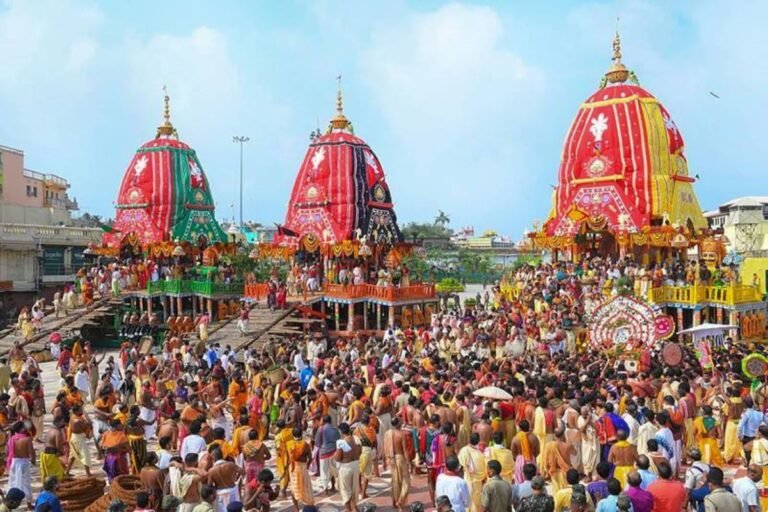Contents
ToggleIn short
Ratha Yatra (Odia: ରଥଯାତ୍ରା), car festival or chariot festival, is a Hindu festival associated with Lord Jagannath held at Shri Kshetra Puri Dham in the state of Odisha, India. It is the oldest Ratha Yatra, descriptions of which can be found in Brahma Purana, Padma Purana and Skanda Purana and Kapila Samhita.
Ratha Yatra, the festival of chariots
Rath Yatra or Jatra is the celebration of Lord Jagannath, which is considered to be the journey of the Lord of the Universe to his aunt's house.
The festival commemorates the annual visit of Jagannath to Gundicha temple via Mausi Maa temple (maternal aunt's house) near Saradha Bali, Puri.
This annual festival is celebrated on Ashadha Shukla Paksha Dwitiya (second day of the bright fortnight of the month of Ashadha).
RATHA YATRA, the chariot festival: the chariots of Shri Jagannath is celebrated every year at Puri, the temple town of Odisha, on the second (dwitiya) day of shukla pakshya (waxing cycle of the moon) of Āshādha Māsa (3rd month of the Odia calendar).
The presiding deities of Jagannath Temple, the main temple of Puri, Lord Jagannath, Lord Balabhadra and Goddess Subhadra, with the celestial wheel – Sudarshana Chakra (ସୁଦର୍ଶନ ଚକ୍ର) are removed from the temple in a ceremonial procession to their tanks.
The huge, colorfully decorated chariots are pulled by a multitude of devotees on the bada danda, the main avenue leading to the Gundicha temple (Gundicha – the queen of King Indradyumna), three kilometers to the north. On the way the chariot of Lord Jagannatha, Nandighosa (ନନ୍ଦିଘୋଷ) waits near the crematorium of Bhakta Salabega (ଭକ୍ତ ସାଲବେଗ), a Muslim devotee, to pay homage.
On their way back from the Gundicha temple, the three deities stop for a while near the Mausi Maa temple (the aunty's abode) and have an offering of Poda Pitha, which is a special type of pancake believed to be the Lord's favorite . After a stay of seven days, the deities return to their abode.
The three chariots of Jagannath, Balabhadra and Subhadra are newly constructed every year with wood from specified trees like phassi, dhausa etc. for the same. The logs are traditionally floated in the form of rafts in the Mahanadi River. These are collected near Puri and then transported by road.
The three floats are decorated according to the unique pattern prescribed and followed for centuries on the Bada Danda, the Grand Avenue. The chariots are lined up on the broad avenue in front of the temple near its eastern entrance, also known as Sinhadwara or the Lion Gate.
Around each of the chariots are nine Parsva devatas, painted wooden images depicting different deities on the sides of the chariots. Each chariot has a charioteer (Sarathi) and four horses.
The construction of the chariots begins on Akshaya Trutiya, the third day of the bright fortnight of Vaisakha, with ritual fire worship. This takes place in front of the Puri King's Palace and opposite the main office of the Puri Temple. On this day, the new agricultural season begins and farmers begin to plow their fields. This day also marks the start of the summer festival of deities, also known as the Sandalwood Festival or Chandan Yatra, which lasts for three weeks.
In this festival, the representative images of the presiding deities are taken out in colorful processions and take a ceremonial boat ride in the Narendra pokhari/tank every day. In an interesting demonstration of the assimilative character of Jagannatha worship, Madanmohana and Rama-Krishna, representing Jagannatha and Balarama, participate in the festival with the images of the representatives of the presiding deities of the five main Shiva temples of Puri.
These are curiously known as Pancha Pandava, the five brothers of the Mahabharata story. Later, the deities have a ritual bath in a small temple in the middle of the tank, in stone vats filled with water, sandalwood paste, perfumes and flowers.
This sandalwood festival culminates with the Snana Yatra, the bathing festival on the full moon day of the month of Jestha. On this day, the presiding deities descend from their seats onto a raised platform in the sanctum sanctorum (Garbha gruha), the jeweled throne. They are bathed in 108 pots of water brought from the suna kua, the well of gold, and take the form of an elephant on the special platform, near the eastern wall of the temple.
From this day on, the deities remain in symbolic and ritual convalescence for approximately two weeks. They are excluded from the sight of ordinary devotees. Only three special patta chitras, traditional Oriya paintings in natural colors on starch-stiffened cloth, known as Anasara Pattis, are strung on a bamboo screen hiding the deities from public view, can be seen by the public. During this period, the deities are given only roots, leaves, berries and fruits to cure them of their ailment.
This ritual is a reminder of the strong tribal elements in the genesis and evolution of the cult of Jagannatha. The offspring of Lalita, daughter of the original tribal worshiper Biswabasu, chief hunter, and the Brahmin priest Vidyapati, are known as daitapatis or daitas. They have the almost exclusive privilege of serving the Lord during convalescence and throughout the period of Ratha Jatra or the Festival of Chariots.
After the chariots of the deities return to the main temple from the Gundicha temple, the deities are dressed in gold ornaments and worshiped on the chariots. This celebration is known as Suna Besha. Tradition holds that this event was first initiated by King Kapilendra Deb in 1460, when after returning victorious from the war, he donated gold to Jagannath. The deities are adorned with gold jewelry weighing nearly 208 kg.
Social networks
Today, Hindus celebrate Ratha Yatra. It is the celebration of Lord Jagannath, Lord of the Universe, traveling to his maternal aunt's house. #calendar #mythology #myth #legend #RathaYatra #hinduism
Picture
